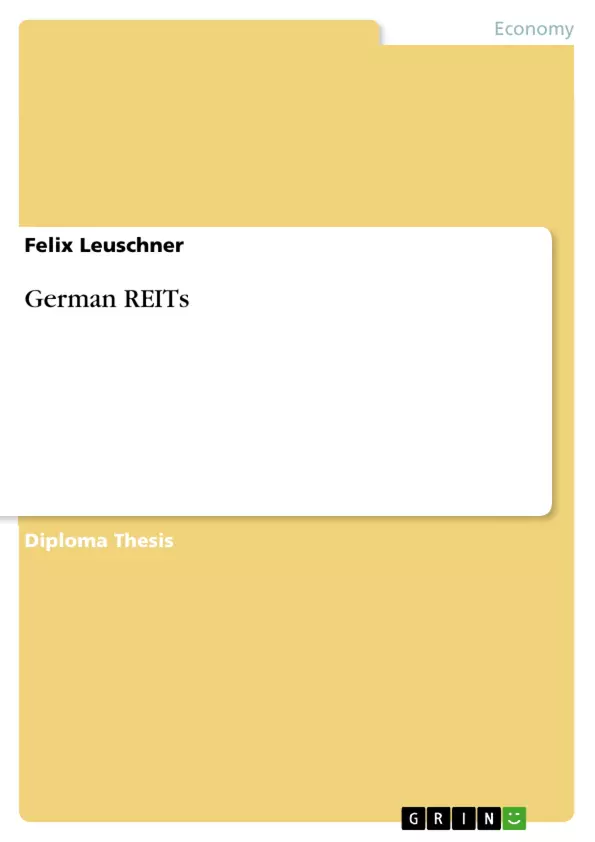A Real Estate Investment Trust (REIT) is a property stock that is taxed, not at the corporate but at the investor level, which can lead to tax advantages.
The concept of REITs originated in the United States in 1960, allowing smaller investors access to large income-producing real estate, which facilitated the creation of a liquid asset class that has become a core part of institutional portfolio management.
REITs have proven attractive to investors because:
x Their returns have beaten most major equity benchmarks over three decades, with lower volatility
x They have predictable cash flows and high dividend yields
x They have a low correlation with other asset classes, aiding portfolio diversification
As US-REITs proved successful, other countries have introduced similar property investment vehicles. The Netherlands started in 1969, followed by Australia (1985), Canada (1994), Belgium (1995), Japan (2000) Singapore (2002), Hong Kong (2003) and most recently France (2003).
In Germany real estate has been the most popular investment theme of the past three years, despite its significant underperformance compared to European peers during the past 10 years, with open-end funds receiving almost all money inflows. The listed sector, however, is insignificant, both in terms of size and liquidity, and is in desperate need of a catalyst. The introduction of a G-REIT structure could potentially be the long-awaited saviour that could transfer the importance of German real estate into the listed sector.
Given the significance of real estate in their respective markets, the German and UK governments are currently considering the introduction of REITs. Depending on the progress of the consultative and parliamentary process, REITs are expected to be enacted by legislation during 2006 in both countries.
The REIT discussion in Germany has reached a serious stage, with all the mostinvolved parties seemingly agreed about the usefulness of a REIT structure.
The purpose of this paper is to highlight the case for REITs in Germany, to analyse the progress of REITs in countries that have installed these structures, to consider the on-going debate in Germany and what these developments may eventually mean for the German real estate market.
Table of Contents
- Executive Summary
- Introduction
- Fundamentals
- Definition and Characteristics of REITS
- Initiation
- Proposed Legal Framework
- Status of the German REIT Discussion
- Overview of existing REIT-Regimes
- Abstract
- Methodology
- Country Overview
- United States
- Japan
- Netherlands
- Belgium
- France
- Analysis of International Comparison
- Best-Practice: A Recommendation for Germany
- The German Real Estate Market
- General Market Structure and Trends
- Fundamentals
- Office Real Estate Sector
- Retail Real Estate Sector
- Industrial real estate sector
- Trends
- Outlook
- The most important German Real Estate Investment Vehicles
- Open-end Property Funds
- Closed-end Property Funds
- Real Estate Companies
- Market Potential for German REITs
- Supply Analysis
- Demand Analysis
- Issues
- Case for Action: Why to introduce REITs in Germany
Objectives and Key Themes
This thesis aims to investigate the potential of Real Estate Investment Trusts (REITs) as a new investment vehicle in Germany, focusing on the current market structure and potential benefits. It analyzes international REIT regimes and explores the German real estate market, highlighting its current investment options and limitations. The analysis ultimately assesses the feasibility of introducing REITs in Germany and outlines the potential impact on the real estate market and investors.
- Analysis of international REIT regimes and their impact on real estate markets
- Evaluation of the German real estate market structure and investment options
- Assessment of the feasibility of introducing REITs in Germany
- Exploration of the potential benefits and challenges associated with REITs in Germany
- Examination of the potential impact of REITs on the German real estate market and investors
Chapter Summaries
The introduction provides a comprehensive overview of REITs, outlining their definition, characteristics, and historical development. It also discusses the global expansion of REITs and highlights the current status of the German REIT discussion.
The second chapter provides a detailed analysis of existing REIT regimes in various countries, including the United States, Japan, Netherlands, Belgium, and France. It examines the legal framework, market structure, and performance of each regime, highlighting key lessons for the German context.
The third chapter examines the German real estate market, focusing on its general market structure, trends, and existing investment vehicles. It analyzes the various property sectors, including office, retail, and industrial, and discusses the market outlook for future growth.
Keywords
This paper examines the potential of Real Estate Investment Trusts (REITs) in Germany. It explores the German real estate market, analyzes existing REIT regimes globally, and investigates the potential impact of REITs on the German real estate market and investors. Key focus areas include real estate investment, market structures, REIT regulations, property investment, and investment vehicles.
- Quote paper
- Felix Leuschner (Author), 2005, German REITs, Munich, GRIN Verlag, https://www.grin.com/document/47823



